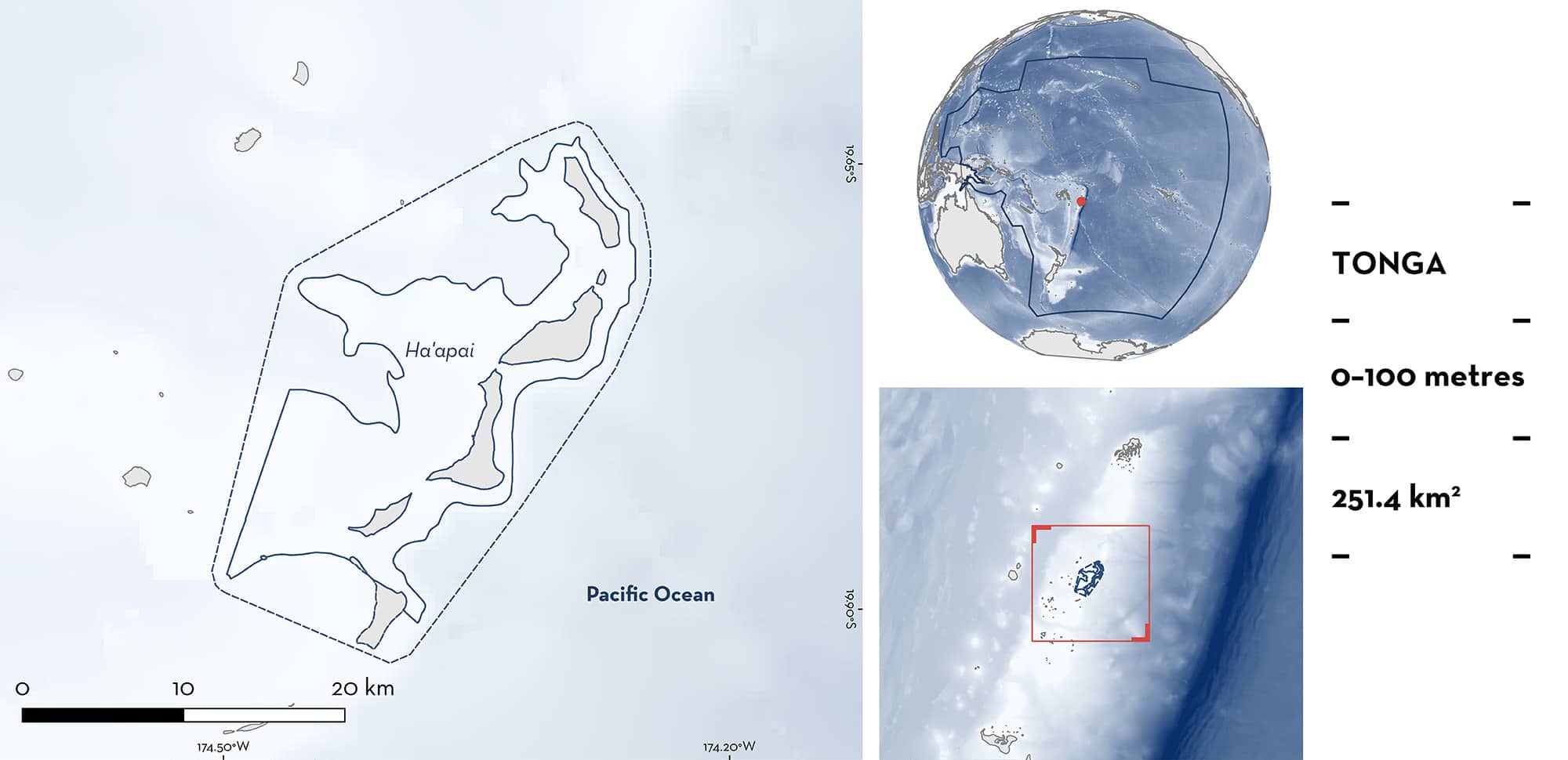ISRA FACTSHEETS
ISRA FACTSHEETS
NEW ZEALAND & PACIFIC ISLANDS REGION
Ha’apai
Summary
Ha’apai is situated in the Kingdom of Tonga. The area encompasses extensive shallow waters, numerous fringing reefs, and isolated reef patches. It overlaps with the Tongan Archipelago Ecologically or Biologically Significant Marine Area. Within this area there are: threatened species (e.g., Indo-Pacific Leopard Shark Stegostoma tigrinum); resting areas (Indo-Pacific Leopard Shark); and undefined aggregations (Blacktip Reef Sharks Carcharhinus melanopterus).
Download factsheet
Ha’apai
DESCRIPTION OF HABITAT
Ha’apai is situated in the Kingdom of Tonga. The area encompasses extensive shallow waters, numerous fringing reefs, and isolated reef patches. It is bordered on the eastern edge by a fringing reef with numerous passages characterised by strong currents (Ceccarelli et al. 2017).
The entire Ha’apai archipelago has high productivity due to localised upwelling from the Tonga Trench and nutrient runoff from land (Ceccarelli et al. 2017). Tonga has a tropical climate characterised by a wet season during austral summer (November–April) and a dry season during winter (May–October) (Tonga Meteorological Service 2020).
This site overlaps the Tongan Archipelago Ecologically or Biologically Significant Marine Area (EBSA; CBD 2024).
This Important Shark and Ray Area is benthic and pelagic and is delineated from inshore and surface waters (0 m) to 100 m based on the depth range of the qualifying species.
CRITERION A
VULNERABILITY
Two Qualifying Species considered threatened with extinction according to the IUCN Red List of Threatened Species regularly occur in the area. These are the Endangered Indo-Pacific Leopard Shark (Rigby et al 2024) and the Vulnerable Blacktip Reef Shark (Simpfendorfer et al 2020).
CRITERION C
SUB-CRITERION C3 – RESTING AREAS
Ha’apai is an important resting area for one shark species.
Based on reports from divers between 2015–2019 and 2023–2024, Indo-Pacific Leopard Sharks are regularly and predictably observed resting in the area on the sandy substrate between patches of reef year-round (A Wessels pers. obs. 2024). The area is a well-known dive location by recreational divers and snorkelers for guaranteed encounters with Indo-Pacific Leopard Sharks. Animals can be observed resting at depths of 10–14 m alone or in pairs. An evaluation of the spot-patterns on the animals (Sharkbook.ai) indicates that records found online are generally new animals appearing in the area during each dive rather than resident animals. The animals observed have an estimated size range of 150–250 cm total length (TL), and the size-at-maturity for this species is 147–183cm TL (Ebert et al. 2021), suggesting observations are of mature individuals. There are no other locations in Tonga where this species has been regularly reported (A Wessels pers. obs. 2024).
CRITERION C
SUB-CRITERION C5 – UNDEFINED AGGREGATIONS
Ha’apai is an important area for undefined aggregations of one shark species.
According to local ecological knowledge, Blacktip Reef Sharks regularly aggregate in this area. Aggregations of 4–8 animals are seasonally observed during the summer (December–March) from shore by beach visitors and snorkelers (A Wessels pers. obs. 2015-2019 & 2023-2024). Aggregations can be generally observed in shallow waters (<0.5 m depth) of the northwest lagoons of Lofotoa and Uoleva Islands, within the area. Animals have an estimated size of 60–80 cm TL. The size-at-birth of this species is 30–52 cm TL and size at maturity ranges between 90–112 cm TL (Ebert et al. 2021), indicating these observations are of juvenile individuals. However, more information is required to determine the nature and function of Blacktip Reef Shark aggregations in this area.
Download factsheet
SUBMIT A REQUEST
ISRA SPATIAL LAYER REQUEST
To make a request to download the ISRA Layer in either a GIS compatible Shapefile (.shp) or Google Earth compatible Keyhole Markup Language Zipped file (.kmz) please complete the following form. We will review your request and send the download details to you. We will endeavor to send you the requested files as soon as we can. However, please note that this is not an automated process, and before requests are responded to, they undergo internal review and authorization. As such, requests normally take 5–10 working days to process.
Should you have questions about the data or process, please do not hesitate to contact us.


